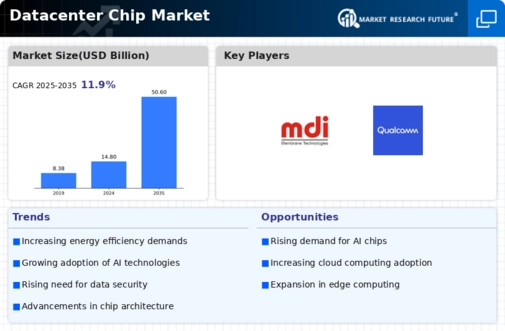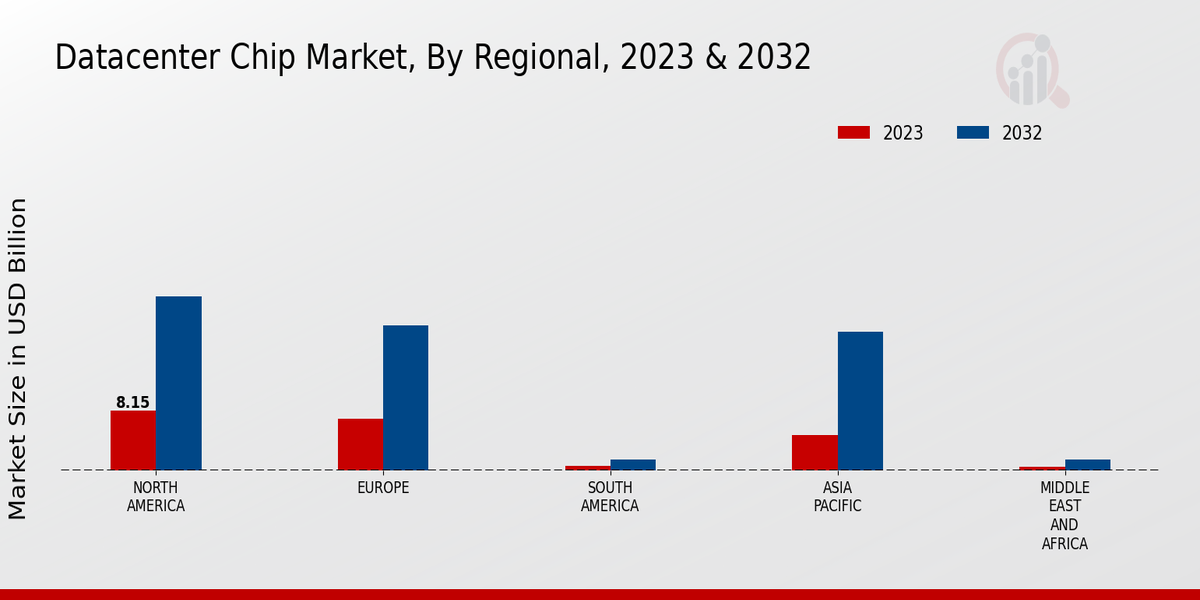Expansion of 5G Networks
The expansion of 5G networks plays a pivotal role in shaping the Global Datacenter Chip Market Industry. The deployment of 5G technology necessitates enhanced data processing capabilities and low-latency solutions, driving demand for advanced datacenter chips. As more devices connect to the internet and generate vast amounts of data, datacenters must adapt to handle this influx. The anticipated growth in 5G infrastructure is expected to contribute to the market's expansion, as organizations seek chips that can support high-speed data transmission and processing. This trend underscores the importance of innovation in chip design to meet the evolving needs of a connected world.
Market Trends and Projections
The Global Datacenter Chip Market Industry is characterized by dynamic trends and projections that indicate substantial growth in the coming years. The market is poised to reach 14.8 USD Billion in 2024 and is projected to expand to 50.6 USD Billion by 2035. This growth trajectory suggests a compound annual growth rate of 11.87% from 2025 to 2035. Key factors influencing this expansion include the rising demand for cloud services, advancements in AI technologies, and the increasing focus on energy efficiency. These trends highlight the evolving landscape of the datacenter chip market and the critical role of innovation in meeting future demands.
Rising Demand for Cloud Services
The Global Datacenter Chip Market Industry experiences a surge in demand driven by the increasing adoption of cloud services across various sectors. As organizations migrate to cloud-based solutions, the need for efficient and powerful datacenter chips becomes paramount. In 2024, the market is projected to reach 14.8 USD Billion, reflecting the growing reliance on cloud infrastructure. This trend is expected to continue, with the market anticipated to expand significantly as businesses seek scalable and flexible computing solutions. The integration of advanced chips in datacenters facilitates enhanced performance, energy efficiency, and cost-effectiveness, thereby supporting the overall growth of the industry.
Growing Focus on Energy Efficiency
Energy efficiency emerges as a critical driver in the Global Datacenter Chip Market Industry, as organizations strive to reduce operational costs and environmental impact. The increasing energy consumption of datacenters has prompted stakeholders to prioritize energy-efficient chip designs. Innovations in chip technology, such as improved thermal management and power optimization, are becoming essential. As a result, the market is likely to experience a compound annual growth rate of 11.87% from 2025 to 2035. This focus on sustainability not only aligns with regulatory requirements but also enhances the overall competitiveness of datacenters, making energy-efficient chips a vital component of future growth strategies.
Increased Investment in Edge Computing
The Global Datacenter Chip Market Industry is witnessing increased investment in edge computing, driven by the need for real-time data processing and reduced latency. As businesses deploy edge devices to enhance operational efficiency, the demand for specialized chips that can support edge computing architectures is rising. This shift towards decentralized computing solutions is likely to reshape the datacenter landscape, requiring chips that can efficiently manage data closer to the source. The growing emphasis on edge computing is expected to propel the market forward, as organizations recognize the value of localized data processing in enhancing performance and responsiveness.
Advancements in AI and Machine Learning
The Global Datacenter Chip Market Industry is significantly influenced by advancements in artificial intelligence and machine learning technologies. These innovations necessitate high-performance chips capable of handling complex computations and large datasets. As AI applications proliferate, datacenters require specialized chips designed to optimize processing power and efficiency. This trend is likely to drive the market towards a projected value of 50.6 USD Billion by 2035. The demand for chips that can support AI workloads is expected to grow, leading to increased investments in research and development. Consequently, the industry may witness a shift towards more sophisticated chip architectures tailored for AI applications.












